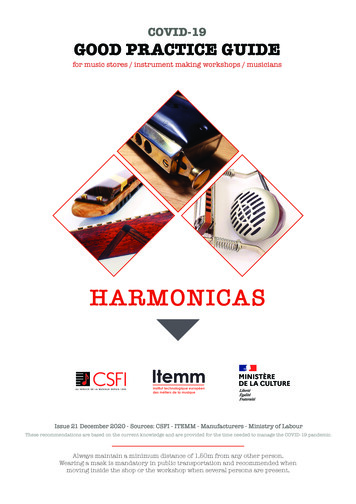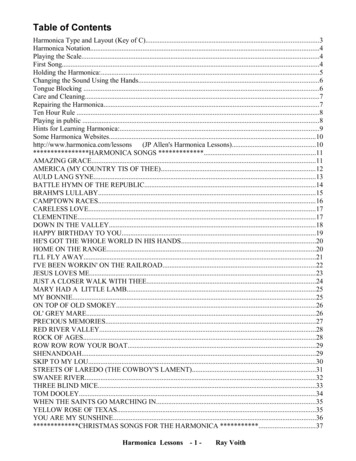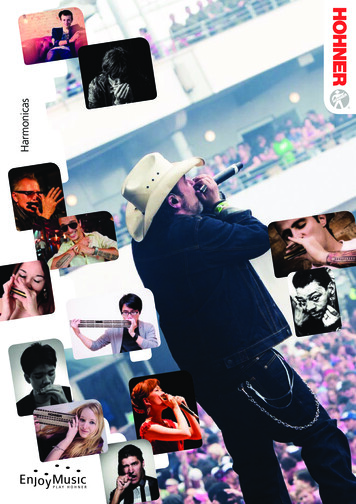
Transcription
COVID-19GOOD PRACTICE GUIDEfor music stores / instrument making workshops / musiciansHARMONICASInstitut technologique européendes métiers de la musiqueIssue 21 December 2020 - Sources: CSFI - ITEMM - Manufacturers - Ministry of LabourThese recommendations are based on the current knowledge and are provided for the time needed to manage the COVID-19 pandemic.Always maintain a minimum distance of 1.50m from any other person.Wearing a mask is mandatory in public transportation and recommended whenmoving inside the shop or the workshop when several persons are present.
C ONTENTSHARMONICASANY TYPE OF DIATONIC OR CHROMATIC HARMONICA.I. General Principles 1/ Preamble 2/ Disinfectant Products and Processes 3/ Cloths and Cleansing Wipes 4/ Quarantine 5/ Face Mask Use II. Harmonicas p3p4p5p5p6p71/ Comb 2/ Plates 3/ Covers 4/ Sliders and Springs III. Accessories Microphones Harmonica Holders Music Scores and Stands 2p3I s s u e 21 D e c e m b e r 2 0 2 0p8p8p9p10p11p11p11p11
G ENER ALPRINCIPLESHARMONICASIMPORTANT REMINDER: This disinfection recommendation guidance must only be followedif you believe you have been in contact with the virus. We recommend, however, that you payspecial attention to the different lacquers and parts of the instrument, and ideally contact yourmanufacturer.When trying an instrument in a store or workshop, should the musician washes / disinfects theirhands correctly, wears a face mask and washes / disinfects their hands once again after tryingthe instrument, the risks of virus transmission between the musician and the instrument willsignificantly be reduced.These recommendations are based on the current knowledge and are provided for the timeneeded to manage the COVID-19 pandemic.1 / P R E A M B LEFollowing are the situations when the instrument / accessory could be contaminated (thesecases depend on whether you are a musician or work in a workshop or a music store): Purchase, rental Repair or maintenance Exhibition / trade show Bench trial in a workshop or a shop Loan, class, rehearsal or live performance Transportation Using / playing the instrument without prior hand washing / disinfecting If someone touches it or gets close to it ( 2m and coughs or talks)In any other case, disinfection is not necessary. Regular cleaning and maintenance of theinstrument and its accessories remain the good practice, whether the virus is present or not.Good practice is common sense Prior to any disinfection, wash / disinfect your hands and clean every part of the instrumentand accessories with a disinfected dry cloth1; Do not use any paper-based material such as paper towels which may scratch the lacquersand leave bits of lint on the surfaces If possible, quarantine the instrument and its accessories, for it will significantly help reducethe virus levels. The virus survival on the different surfaces depends on multiple parameterssuch as material, texture, humidity, presence of proteins and bio film. Preliminary data givea more accurate evaluation of the necessary quarantine duration according to the material.Please read Section 4 for further information about the quarantine. Before applying any of the products listed below on the entire instrument and its accessories,please try on a small part of it When multiple persons are playing or using an instrument and its accessories, encouragethem to use at least a surgical face mask and wash / disinfect their hands.(1): Do not use the cloth multiple times without either disinfecting it with an effective product, or washing it at60 C or higher for over 30 minutes. Otherwise, throw it away in an airtight container.Issu e 21 D e c e m b e r 2 0 2 03
G ENER ALPRINCIPLESHARMONICAS2 / D I S I N F E CTANT PR OD UCTS AND PR OCESSESThe following products allow for disinfection which will significantlyreduce the virus levels.You will find in the second part of this document a list of products suited for the differentparts of your instrument: Chlorate derivatives: bleach 0.5%. The value represents the sodium hypochloriteconcentration. It’s usually available with a 2.6% concentration – or a 5 times maximum dilution– which means one dose of the 2.6% product for 4 doses of cold water. 70% Alcohol. Alcohol is a well-known virucidal agent. Here’s a list of recommended alcohols:- Ethanol (the most common)- Isopropyl alcohol- Their concentration must be at least 70% (drugstores). NF EN 14476 standard compliant products (Sanytol , Sani-Cloth ), in which hydrogenperoxide or quaternary ammoniums (didecyldimethylammonium chloride) are the mostcommon active agents ; please strictly follow the instructions of use (e.g. contact time). Theseare often alcohol-free solutions. Soap. Certain soaps have proven effectiveness in deactivating the virus but only after 3minutes of use. These are:- KLINTE DE soap, diluted 10 times- Little Marcel Green Soap , effective when diluted up to 10 times.However, this effectiveness is not guaranteed for all soaps and application modes. Other productsshould therefore be preferred whenever possible. Most notably, soap cannot be applied on aninstrument with a friction that is equivalent to that of the hands, nor with the same amount ofwater. It’s probably not as efficient when only “applied” and wiped up.Non-Validated ProductsThe following products have been tested against active SARS-CoV-2 but have not demonstratedsufficient efficiency as a disinfectant. 3% hydrogen peroxide (or 10 volumes).4I s s u e 21 D e c e m b e r 2 0 2 0
G ENER ALPRINCIPLESHARMONICASDisinfection ProcessesWe can see, especially on the Internet, that UV- or ozone-based processes are used for disinfectingmusic instruments and other products. Extreme caution is required when using these methods topotential health risks, if they have not been certified by independent, scientific and professionalorganizations. Ultraviolets treatments can be efficient in certain contexts but they must be handledwith extreme caution because they may be harmful to the skin and eyes and may form ozone,which is toxic. Moreover, these processes do not guarantee full efficiency, in particular whenspecific parts cannot be lit. It is important to take into account the UV-C light wave length(220 to 280nm), its power, distance and exposure duration. These treatments may also damagethe lacquers, especially on string quartet instruments. In any case, the provider must presentevidence of the effectiveness of such approach (in particular the time required to deactivateSARS-CoV-2). Ozone in gas phase may deactivate viruses, but at high concentrations only, which willbe harmful to human beings. Its use requires very specific knowledge and skills. It is notparticularly recommended to this day.3 / CLO TH S A N D CLE ANSING W IP ES Microfiber cloths that won’t scratch the lacquers can be reused after being disinfected orwashed ( 30 minutes, 60 C, with a detergent product). Non-impregnated polishing cloths or wipes can be reused after disinfection or wash ( 30minutes, 60 C, with a detergent product). Pre-impregnated wipes, please ensure that these are NF EN 14476 standard compliant2,that they are not abrasive and follow their instructions of use. Please pay attention to the stringquartet instrument lacquers and check compatibility, in particular when using alcohol products. Avoid any paper towels on the lacquers, but preferably use cotton cloths instead.(2) NF EN 14476 standard means that the product inactivates 99.99% viruses (per 10,000 division) in theprotocol provided by the manufacturer.4 / Q UA R A NTINEQuarantine duration has not been clearly defined yet, because it depends on multiple factors(material of the surface to be decontaminated, room ventilation, humidity, temperature, andmore).Several results have emerged. Most notably, the common 3-day duration is in no way thegeneric rule. The instrument or accessory material must be taken into account. The list belowdescribes the materials for which the viral load is sufficiently reduced. These results follow fromtrials carried out by a French Institute using SARS-CoV-2, for the purposes of the PIC Project(Protocoles pour les Instruments face au Coronavirus / Procedures against Coronavirus forMusic Instruments). This is the second part of the PIC Project, the first one being the writing ofthese guidebooks.Issu e 21 D e c e m b e r 2 0 2 05
G ENER ALPRINCIPLESHARMONICASMaterials on which the virushas been sufficiently deactivated (disinfection)after 3 daysSilverNickelNickel SilverGold PlatingABS PlasticPolyurethane VarnishNitrocellulose VarnishMaterials on which the virus is still activein significant amounts after 3 days,(quarantine during at least 6 days as a precaution)EboniteBrassOil-Based VarnishAlcohol-Based VarnishEpoxy Resin-Based Varnish5 / FACE MAS K US E Wearing a face mask is mandatory when being near other persons. Strictly follow the protocol to wear your mask:How do I put my surgical face mask on?1Wash yourhands2Flip your mask to theright side (stiff edgeis the top, white sidetowards your face)3Tie the topties of yourface mask4Pinch the stiff edgeto adjust it to theshape of your nose5Tie the bottomties of yourface mask French Ministry of Health6I s s u e 21 D e c e m b e r 2 0 2 06To remove it,only touch the ties7Throw the facemask away andwash your hands
T YPESOF HARMONICASHARMONICASDESCRIPTION OF THE DIATONIC HARMONICAReedsTop CoverPlateCombPlateBottom CoverDESCRIPTION OF THE CHROMATIC HARMONICATop CoverSlider with buttonSlider with shutterCombPlatesand BladesMouthpieceBottom CoverIssu e 21 D e c e m b e r 2 0 2 07
T YPESOF HARMONICASHARMONICAS1 / CO M BComb material and coating are the main elements that will determine which disinfectant mustbe used, because they are generally the most delicate parts of the instrument. The comb can bemade of wood, plastic, metal, and more. It can also be varnished.Many harmonica teachers recommend using alcohol to disinfect the instrument after eachcontagious disease episode (sore throat, influenza.). Repeated and prolonged disinfectionmust be avoided in order to protect the instrument. Do not soak it in alcohol for more than afew seconds, for instance. Warning: some materials (such as Bio-based PLA) can be sensitive toheat-up. You can also use the mouthpiece cleansing product featured in the Hohner cleaning kit(not tested for COVID-19 virus).Process1. Wash / disinfect your hands.2. Disassemble the instrument (it usually features a cap screwbut other systems are used, such as the Yonberg’s).3. Use a swab or a pipe cleaner that was previously impregnated with 70% or higher alcohol toclean each of the comb holes. Clean the rest of the comb with a soft cloth moistened with alcohol.4. Do not soak the cleansing cloth / swab / pipe cleaner with the product.5. Do no reuse the cloth / swab / pipe cleaner after disinfection (sanitize, wash or throw it away).2 / PL ATESPlates are generally made of phosphorus steel, but manufacturers may use stainless steel onsome models. Please read the manufacturer’s recommendations for further information.The free reeds are usually riveted to the plates. Some luthiers or harmonicists choose to varnishthe rivets in order to increase the waterproofing, for specific adjustments or to remove anyunwanted noise.Prefer alcohol to disinfect the instrument.The difficulty is to clean it without changing the settings. The distance between the reeds and theplates varies in order to facilitate certain playing techniques such as overdraws and overblows.Changing the reed position would alter the setting and therefore confuse the musician.Process1. Wash / disinfect your hands.2. Disassemble the instrument.3. Soak the plates for a few seconds in 70% or higher alcohol.4. Let dry before reassembling the instrument.5. If needed, varnish the rivets again if the coating was dissolved in the alcohol.8I s s u e 21 D e c e m b e r 2 0 2 0
T YPESOF HARMONICASHARMONICAS3 / COVE RSThe disinfection technique will vary according to the cover material. Each model has its owncharacteristic. Please contact the manufacturer to receive further information about the covermaterial.These elements are rigid. Please proceed the same way as for the comb.Process1. Wash / disinfect your hands.2. Disassemble the instrument.3. Use a swab or a pipe cleaner that was previously impregnated with 70% or higher alcoholto clean the cover angles. Clean all accessible and flat parts of the covers with a soft clothmoistened with alcohol.4. Do not soak the cloth / swab / pipe cleaner with the product.5. Lubricate the slide before reassembling.6. Do no reuse the cloth / swab / pipe cleaner after disinfection (sanitize, wash or throw it away).Products /Disinfection ProcessesChlorate derivatives comingfrom bleach 0.5 %70% Alcohol95% Alcohol,Please follow the protocol14476 standard compliantproducts(Sanytol , Sani-Cloth , etc.)UV-CMetallic partsOiled wooden partsVarnished woodenparts in contactwith mouthReedsTo be testedNoNoNoTo be testedTo be testedTo be testedNoYesTo be testedYesYesTo be testedTo be testedTo be testedTo be testedTo be tested, only when disassembledNOTE: Denaturated alcohol might leave deposits (by-produced by evaporation). A nondenaturated 95 industrial alcohol should be preferred.Issu e 21 D e c e m b e r 2 0 2 09
H ARMONICASHARMONICAS4 / S LI D E RS AND S PR INGSIf these are metal parts, they can be soaked in alcohol, and even scrubbed with a soft cloth /swab / pipe cleaner.It would be preferable to clean the slider mechanism without taking the plates apart to avoid thecomb from twisting when the mouthpiece is not present.When removing the slider components, be careful not to loose the buffers. Then clean all theparts with the mouthpiece cleansing product and cloth. When the operation is completed, applya very thin layer of lubricating oil on both sides of the slider. Important: Use this lubricating oilsparingly and make sure it doesn’t leach into the instrument as it would then glue the valvesand make the instrument impossible to play.Process1. Wash / disinfect your hands.2. Disassemble the instrument.3. Soak the different parts of the slider mechanism in 70% or higher alcohol, if these parts aremetal, or use a soft cloth / swab / pipe cleaner moistened with alcohol.4. Do no reuse the cloth / swab / pipe cleaner after disinfection(sanitize, wash or throw it away).10I s s u e 21 D e c e m b e r 2 0 2 0
A CCESSORIESHARMONICASMI C R O PH O NE SWhen using microphones to amplify harmonicas, windscreens which can be disinfected aftereach use are to be preferred.The microphone must be disconnected and the phantom power disabled.Once again, always test the selected compatible product on a small part of the equipment inorder to check the result before applying it to the whole equipment.Process1. Wash / disinfect your hands.2. Spray the product directly onto the whole surface of the microphone. Caution: do not sprayonto ribbon or condenser studio microphones.In this case, moisten a cloth with the disinfecting product and rub the whole surface of themicrophone.3. Wipe off any excess product.4. Place the microphone in its pouch, carrying bag or case and make sure it’s not humidanymore (which could cause condensation on the diaphragm once placed in its closed pouch).Products /Disinfection ProcessesChlorate derivatives comingfrom bleach 0.5 %Mic DiaphragmDynamicMic DiaphragmCondenserMicrophone BodyTo be testedTo be testedTo be testedYesYesYes70% Alcohol14476 standard compliantproducts(Sanytol , Sani-Cloth , etc.)Yes,Some leave greasyresidueUV-CYes,Some leave greasyresidueYes,Some leave greasyresidueTo be testedH A RM O N I CA HOLD E R SPlease check harmonica compatibility according to the material. Holders are usually made ofmetal and can be cleaned using 70% or higher alcohol.SCORESExcept a 6 to 9 day quarantine, there is currently no known solution to disinfect music scores.We recommend covering the pages with plastic sleeves as these can be cleaned with alcohol.MUS I C STA ND SMusic stands are usually made of metal. Therefore, they can be cleaned with 70% alcohol.Issu e 21 D e c e m b e r 2 0 2 011
IN COLLABORATION WITHITEMM Romain VIALACSFI Jacques CARBONNEAUXSandrine BALLE (Harmonica manufacturer)Graphic Design Stéphane NEIDHARDT - Angéline RELLO (BUFFET-CRAMPON)Soutenupar
Harmonica Holders p11 Music Scores and Stands p11 ANY TYPE OF DIATONIC OR CHROMATIC HARMONICA. CONTENTS. 3 HARMONICAS Issue 21 December 2020 . common active agents ; please strictly follow the instructions of use (e.g. contact time). These are often alcohol-free solutions. Soap. Certai

